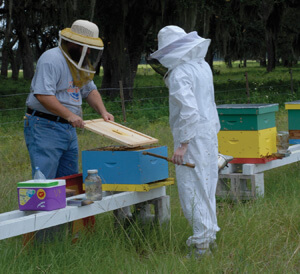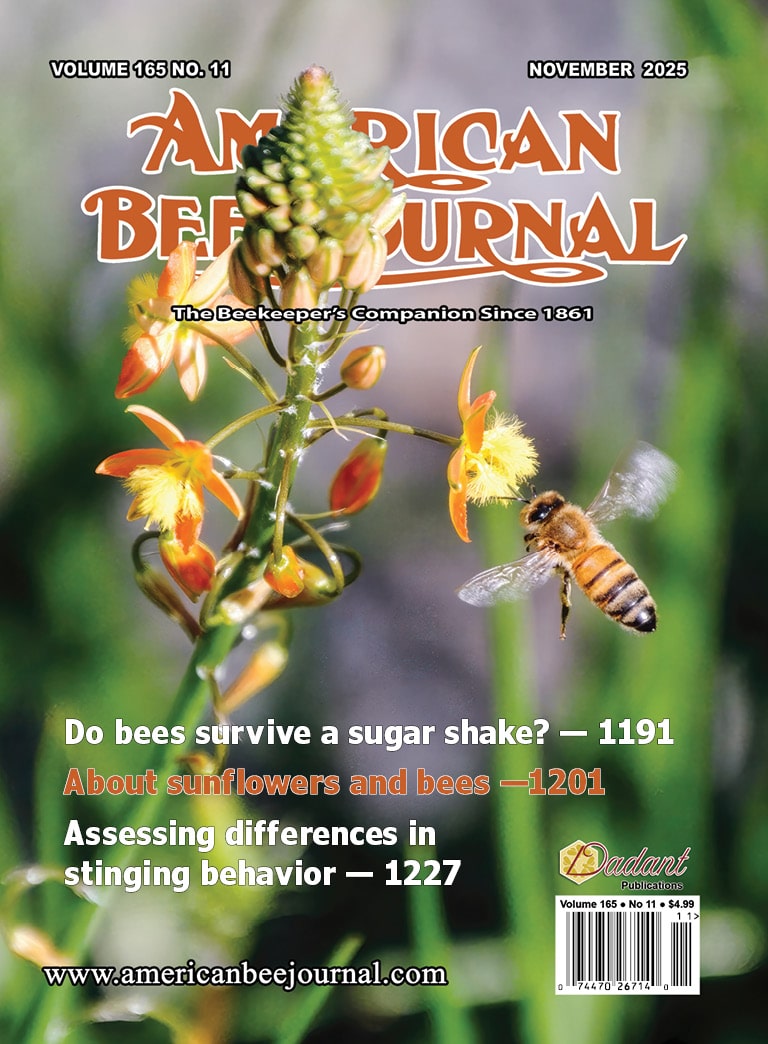
It is common for me to get questions related to proper techniques for inspecting hives. Beekeepers, especially new beekeepers, want to know how often they should inspect their hives, what tools are needed when performing a standard inspection, and what they should look for when inspecting a hive. I will address these questions herein. I will note that inspection strategies and frequencies change based on the time of year, the number of hives one has to inspect, and what one hopes to accomplish with their hives. Correspondingly, I will limit myself to discussing what one should do during the most basic of hive inspections.
Common Equipment Needed for Hive Inspections
Beekeepers need the appropriate equipment before they can conduct a successful hive inspection. Of course, the equipment a beekeeper needs with him/her varies tremendously depending on the intent of the inspection. Most general inspections can be performed with little more than a smoker, hive tool, and bee veil. The more complex inspections (those during which multiple management activities such as feeding, medicating, supering, etc. are performed) require more than the basic equipment. Given the diverse nature of inspections, I will focus on the most basic equipment one would want with them when conducting a general inspection. I will start with the necessary equipment (i.e. that equipment I think you need with you every time you inspect a hive) and follow that with a list of optional equipment (equipment I personally think is best to have with you, though I admit that not everyone will need what I list).
Necessary equipment
1) hive tool – This tool is an essential piece of beekeeping equipment. Bees glue all components of a hive together with a sticky substance called propolis. The hive tool is used to pry apart supers, pry frames out of supers/hive bodies, etc. I have tried to use other similar items in place of a hive tool, including butter knives, screwdrivers, and things that look like hive tools (similar items sold at hardware stores, but that are not hive tools). However, nothing functions like a hive tool. Accept no substitutes. Hive tools are made to survive the stress of working hives. Purchase more than one. I recommend keeping a spare hive tool in your vehicle and even at your apiary if you are someone who is prone to losing things.
2) smoker – The smoker is an essential tool. Smokers, when lit properly, produce copious amounts of smoke. Beekeepers use smokers to calm the bees. Smoke calms bees by masking the alarm pheromone bees produce when they become defensive. I know that some beekeepers think it is best for the bees to avoid using smoke altogether. I disagree. I think that a smoker should be lit and nearby any time a hive is inspected. Colony behavior changes from day-to-day. You never know when a “normally gentle” colony is going to express heightened defensive behavior as a result of whatever stimulus triggers the response that day.
3) smoker fuel – Beekeepers should have dry smoker fuel on hand when inspecting a hive. It benefits the beekeeper to be proactive in this regard. I recommend having a large reservoir of dry fuel available at all times. I also recommend having a small amount (about 1 quart’s worth) of shredded newspaper that one can use to start a smoker. Whatever fuel you elect to use, make sure (1) it is dry, (2) you have enough to keep a smoker going a few hours, and (3) it has no chemical contaminations that might be harmful to you and/or the bees if it is heated.
4) lighter/matches – There are three levels of fire starters I see beekeepers use. The most basic of these is the match. I try to have a box of matches on hand in the event that my lighters are out of fuel. You can purchase waterproof match holders from most camping supply stores. You can store matches in these and protect them from the elements, increasing their longevity, and making them more likely to work when you otherwise forgot or lost your lighter. The second type of lighter is the basic fuel-powered lighter. This includes cigarette lighters and the trigger-lighters that you often see in grill or bar-b-que sections of stores. The third type of lighter is really just a juiced-up version of the second type. It is a lighter head that is mounted on a small fuel tank. This is more like a torch and less like a lighter. However, they are great, seem to always work, and can even be used to light damp fuel, something that a match and a basic lighter usually cannot do.
5) smoker box – In my old age, and after seeing smokers be responsible for starting two fires, I recommend beekeepers have a smoker box or other metal container in which a lit smoker can be stored during transit. This should limit smoker ability to start fires where fires are not otherwise wanted. It is preferable to put the smoker out after use anyway. However, some beekeepers put lit smokers in the back of their trucks. This is a perfect example of when to use a smoker box. I happen to use a small metal pail for this purpose.
6) personal protective equipment (PPE) – Beekeepers should wear at least a veil when inspecting a hive (Figure 1). Of course, the amount of PPE you elect to wear (veil, gloves, boots, suit) is up to you. However, I believe that you should wear at least a veil. Bee stings on/around the face can be quite problematic. This is especially true of bee stings on the eyeball, which can leave you blind in the stung eye if not treated properly and quickly. Even if you only wear a veil, it is advisable to have a pair of gloves or even a suit on hand in the event the bees get particularly testy.
7) notebook/pen/pencil – It is a good idea for you to have items needed for note taking purposes when inspecting a hive. Keeping good notes on the status of a hive, what management practice you most recently performed on/to the hive, etc. can help you know what should be done to the hive in the future should you ever need that information. You also can record information on colony productivity, disease and pest pressures, feeding schedule, and a number of other management-related items. I recommend having a waterproof writing tablet and use a waterproof pen. Both are cheap and readily available in most office supply stores.
Optional equipment
1) a small pair of scissors – I clip all of my queens as part of my swarm control strategy. Correspondingly, I carry a small pair of nail scissors (Figure 2) with me when I inspect a hive. That way, I have a pair handy any time I have a new queen in a hive (Figure 3).
2) small painting device or marker pen – I also like to mark my queens, just to make them easier to find. Thus, I carry with me a small paint “brush” and a small vial of paint (Figure 2). The “brush” I use is really just a small nail that has a round head the size of the mark I want to make on the queen. I wrap the shaft of the nail with a bit of duck tap to create the handle for the “brush”. I am sure you can hammer the nail into the end of a wooden dowel rod and achieve the same thing. My mentor liked to use a small paintbrush from which he would remove most of the bristles. These days, the paint pens are quite popular and useful. Not everyone will need this piece of equipment, as many beekeepers do not mark their queens. However, I like to have the marking device on hand. When I do, I tend to mark my queens (Figure 4).
3) queen cages – I carry a few queen cages with me when I inspect hives (Figure 5). That way, I have a place to put queens when needed. Believe it or not, I do this quite a bit. For example, I like to allow my freshly marked queens to …
Photo Caption
Figure 1 – Two beekeepers wearing different amounts of personal protective equipment (PPE). The beekeeper on the left is only wearing a veil while the one on the right is wearing a full suit. You should wear the amount of PPE that you are comfortable wearing. I recommend always wearing at least a veil. Photograph: University of Florida.


